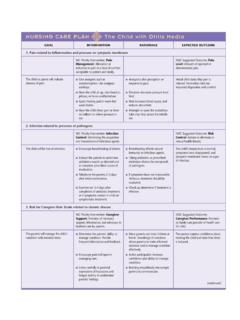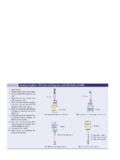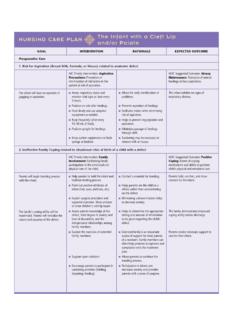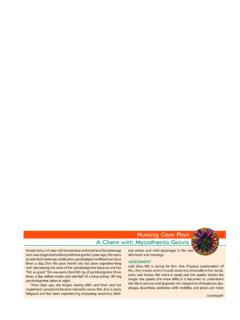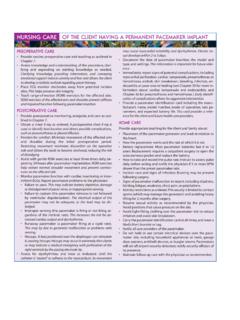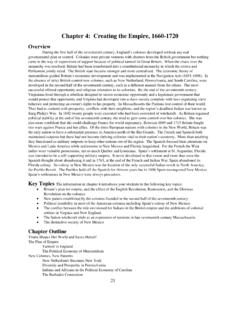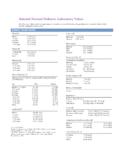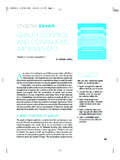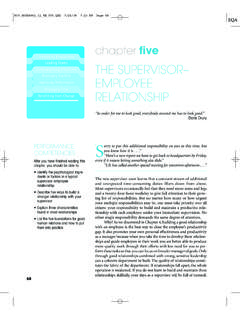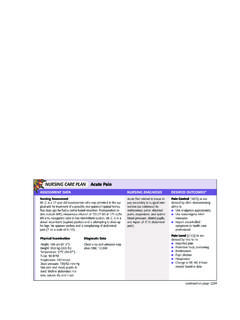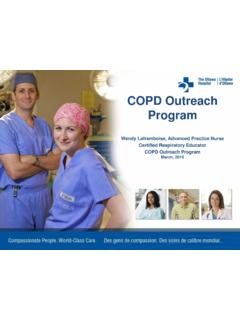Transcription of NURSING CARE OF THE CLIENT HAVING A CORONARY …
1 CHAPTER 29 / NURSING care of clients with CORONARY Heart Disease 823. NURSING care OF THE CLIENT HAVING A CORONARY artery BYPASS GRAFT. PREOPERATIVE care Assess skin color and temperature, peripheral pulses, and level Provide routine preoperative care and teaching as outlined in of consciousness with vital signs. Pale, mottled, or cyanotic col- Chapter 7. oring, cool and clammy skin, and diminished pulse amplitude are Verify presence of laboratory and diagnostic test results in the indicators of decreased cardiac output. chart, including CBC, coagulation profile, urinalysis, chest X- Continuously monitor and document cardiac rhythm. ray, and CORONARY angiogram. These baseline data are important Dysrhythmias are common, and may interfere with cardiac filling for comparison of postoperative results and values.
2 And contractility, decreasing the cardiac output. Type and crossmatch four or more units of blood as ordered. Measure intake and output hourly. Report urine output less Blood is made available for use during and after surgery as than 30 mL/h for 2 consecutive hours. Intake and output meas- needed. urements help evaluate fluid volume status. A fall in urine output Provide specific CLIENT and family teaching related to proce- may be an early indicator of decreased cardiac output. dure and postoperative care . Include the following topics. Record chest tube output hourly. Chest tube drainage greater Cardiac recovery unit; sensory stimuli, personnel; noise and than 70 mL/hr or that is warm, red, and free flowing indicates alarms; visiting policies hemorrhage and may necessitate a return to surgery.
3 A sudden Tubes, drains, and general appearance drop in chest tube output may indicate impending cardiac tam- Monitoring equipment, including cardiac and hemody- ponade. namic monitoring systems Monitor hemoglobin, hematocrit, and serum electrolytes. A. Respiratory support: ventilator, endotracheal tube, suction- drop in hemoglobin and hematocrit may indicate hemorrhage ing; communication while intubated that is not otherwise obvious. Electrolyte imbalances, potassium, Incisions and dressings calcium, and magnesium in particular, affect cardiac rhythm and Pain management contractility. Preoperative teaching reduces anxiety and prepares the CLIENT Administer intravenous fluids, fluid boluses, and blood trans- and family for the postoperative environment and expected sen- fusions as ordered.
4 Fluid and blood replacement helps ensure sations. adequate blood volume and oxygen-carrying capacity. Administer medications as ordered. Medications ordered in the POSTOPERATIVE care early postoperative period to maintain the cardiac output in- Provide routine postoperative care as outlined in Chapter 7. In clude inotropic drugs ( , dopamine, dobutamine) to increase addition to the care needs of all clients HAVING major surgery, the force of myocardial contractions; vasodilators ( , nitroprus- the cardiac surgery CLIENT has specific care needs related to side or nitroglycerin) to decrease vascular resistance and after- open-heart and thoracic surgery. These are outlined under the load; and antidysrhythmics to correct dysrhythmias that affect NURSING diagnoses identified below.
5 Cardiac output. Keep a temporary pacemaker at the bedside; initiate pacing as Decreased Cardiac Output indicated. Temporary pacing may be needed to maintain the car- Cardiac output may be compromised postoperatively due to diac output with bradydysrhythmias, such as high-level AV. bleeding and fluid loss; depression of myocardial function by blocks. drugs, hypothermia, and surgical manipulation; dysrhythmias; in- creased vascular resistance; and a potential complication, cardiac PRACTICE ALERT Assess for signs of cardiac tampon- tamponade, compression of the heart due to collected blood or ade: increased heart rate, decreased BP, decreased urine output, in- fluid in the pericardium creased central venous pressure, a sudden decrease in chest tube Monitor vital signs, oxygen saturation, and hemodynamic pa- output, muffled/distant heart sounds, and diminished peripheral rameters every 15 minutes.
6 Note trends and report significant changes to the physician. Initial hypothermia and bradycardia pulses. Notify physician immediately. Cardiac tamponade is a life- are expected; the heart rate should return to the normal range threatening complication that may develop postoperatively. Car- with rewarming. The blood pressure may fall during rewarming diac tamponade interferes with ventricular filling and contraction, as vasodilation occurs. Hypotension and tachycardia, however, decreasing cardiac output. Untreated, cardiac tamponade leads to may indicate low cardiac output. Pulmonary artery pressure cardiogenic shock and possible cardiac arrest.. (PAP), pulmonary artery wedge pressure (PAWP), cardiac output, and oxygen saturation are monitored to evaluate fluid volume, cardiac function, and gas exchange.
7 Hemodynamic monitoring is Hypothermia further discussed in chapter 30. Hypothermia is maintained during cardiac surgery to reduce the Auscultate heart and breath sounds on admission and at metabolic rate and protect vital organs from ischemic damage. least every 4 hours. A ventricular gallop, or S3 , is an early sign of Although rewarming is instituted on completion of the surgery, heart failure; an S4 may indicate decreased ventricular compli- the CLIENT often remains hypothermic on admission to cardiac ance. Muffled heart sounds may be an early indication of cardiac recovery. Gradual rewarming is necessary to prevent peripheral tamponade. Adventitious breath sounds (wheezes, crackles, or vasodilation and hypotension. rales) may be a manifestation of heart failure or respiratory compromise.
8 Continued 824 UNIT VIII / Responses to Altered Cardiac Function NURSING care (continued). Monitor core body temperature ( , tympanic membrane, atively. Decreased chest expansion or asymmetrical movement pulmonary artery , bladder) for the first 8 hours following sur- may indicate impaired ventilation of one lung, and needs further gery. Oral and rectal temperature measurements are not reliable evaluation. indicators of core body temperature during this period. Note endotracheal tube (ETT) placement on chest X-ray. Mark Institute rewarming measures ( , warmed intravenous solu- tube position and secure in place. Insert an oral airway if an tions or blood transfusion,warm blankets,warm inspired gases, oral ETT is used. The chest X-ray documents correct ETT place- radiant heat lamps) as needed to maintain a temperature ment above the bifurcation to the right and left mainstem above F (36 C).
9 Administer thorazine, morphine, or dilti- bronchus. Marking its appropriate placement allows evaluation azem as ordered to relieve body temperature may of potential tube movement. Secure the tube firmly in place to cause shivering, increasing oxygen demand and consumption. prevent slippage or inadvertent removal. An oral airway helps Hypothermia also increases the risk for hypoxia, metabolic acido- prevent obstruction of an oral ETT by biting. sis, vasoconstriction and increased cardiac work, altered clotting, Maintain ventilator settings as ordered. Monitor arterial blood and dysrhythmias. gases (ABGs) as ordered. Mechanical ventilation promotes opti- mal lung expansion and oxygenation postoperatively. ABGs are Acute Pain used to evaluate oxygenation and acid-base balance.
10 Following a CABG,pain is experienced due to both the thoracic in- Suction as needed. (See Procedure 36-X.) Suctioning is per- cision and removal of the saphenous vein from the leg. Dissection formed only as indicated to clear airway secretions. of the internal mammary artery (usually the left IMA) from the Prepare for ventilator weaning and extubation, as appropri- chest wall also causes chest pain on the affected side. Chest tube ate. The CLIENT is removed from the ventilator and extubated as sites are also uncomfortable. The leg from which the saphenous soon as possible to reduce complications associated with me- vein graft was obtained may be more painful than the chest inci- chanical ventilation and intubation. sion. After extubation, teach use of the incentive spirometer, and Frequently assess for pain, including its location and character.
